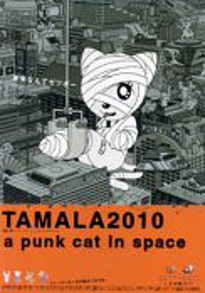Review
by Zac Bertschy,Tamala 2010
| Synopsis: |  |
||
Tamala 2010: A Punk Cat in Space follows the hyperactive, non-sequitur adventures of Tamala, a little kitty with a spaceship. On her way to Orion, her ship is diverted to Planet Q, a place where dogs rule. Chased by a degenerate cop while evading society with the help of love interest Michelangelo, Tamala uncovers not only the secrets behind ‘Catty & Company’, the huge megaconglomerate that rules the Feline Galaxy, but also her own identity. That, and a whole lot of really weird stuff happens. |
|||
| Review: | |||
The product of an artist group called Trees of Life (“t.o.L”), Tamala 2010: A Punk Cat in Space is as strange a thing as you'll ever see. Doubtlessly produced under the influence of past animated ‘head trips’ like The Beatles' classic film Yellow Submarine, Tamala 2010 is, without a doubt, something that will only appeal to a very specific audience: art students and college kids strung out on illegal substances. Tamala 2010 follows something of a storyline. Basically, we follow Tamala, a sort of Hello Kitty-alike who swears like a sailor and flies around in her retro spaceship. Engine trouble pops up, and she's mistakenly rerouted to Planet Q, a place inhabited almost enitely by dogs. There's a mild terrorism problem; dogs attack cats at random. Meeting up with a cat named Michelangelo, Tamala evades a perverted canine policeman and uncovers a whole load of mysteries and secrets surrounding Catty & Company, the gigantic corporation that controls nearly everything in the Feline Galaxy. That description, of course, makes the film sound fairly straightforward and simple, which is, unfortunately, not the case. The movie goes off on a series of hallucinogenic tangents that have almost nothing to do with the main storyline and will confuse anyone who isn't paying strict attention. The irony is that the film seems to have been designed to make the viewer tune out, so paying strict attention might be missing the point. Deciphering Tamala 2010's message is fairly difficult. A single viewing of the film won't reveal much of anything, except a warped sort of anti-capitalist message that doesn't really assert itself due to the totally detached and apathetic main character. Catty & Company winds up being connected to a bizarre religious cult and supposedly has the ability to make and remake the universe in its own image; this all connects to Tamala, who doesn't seem to really care about anything that's happening around her. A visit to the t.o.L website reveals that the purpose of Tamala is to create a worldwide merchandising franchise, something that will basically do what Sanrio's wretched saccharine creations have already done. Great. So what's the point? Well, for most people, the point is that this film is something to watch while stoned, created by artists who were also stoned. This conclusion is a little unfair; these days we have a tendency to attribute anything even slightly surreal or abstract to the abuse of narcotics, which undermines the entire concept of creativity. Tamala 2010, while certainly as tangential and nonsensical as your favorite addict's acid trip stories, seems to be the concentrated effort of a group of artists to create something more than just entertainment. Whether or not they were successful is another matter entirely; if this really was an attempt at sparking a worldwide phenomenon, then why did they produce a cultish, R-rated animated movie with which to promote their concept? Only t.o.L really knows what the purpose of this film was, and we, as viewers, are asked simply to consume and draw our own conclusions. Artistically, the film is unique. The characters are animated in a sort of Flash-like fashion, with smooth and simple movements. Vehicles and some backdrops are animated in 3-D; the result is a piece of pop art unlike anything else. The film is mostly in black and white, using color very sparingly. It's hard to tell if the visual style of this film is intended to put across any sort of message; you just never know with films like this one. The soundtrack is a surprisingly pleasant trance mix, perfectly suited for the visuals. As an art piece, Tamala 2010 does not disappoint. Basically, if you're a film student, or an art student, you owe it to yourself to see this film at least once. It's one of those cult events that any serious underground culture junkie will have seen. The artist group that created it seems strangely cultish, and it's a wonder there isn't more information out there regarding them and their project. Whatever conclusion you come to, Tamala 2010 is a unique experience, totally different from anything else available on the market today (aside from, you know, Cat Soup and Yellow Submarine). |
| Grade: | |||
|
Overall (sub) : B+
Story : B
Animation : B
Art : A
Music : A
+ Unique, artistically valid. |
|||
| Production Info: | ||
|
Full encyclopedia details about |
||